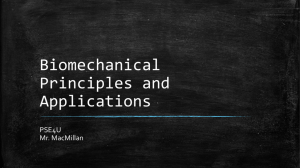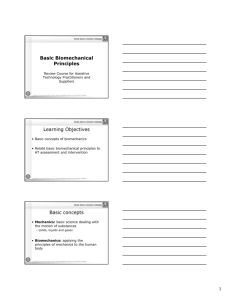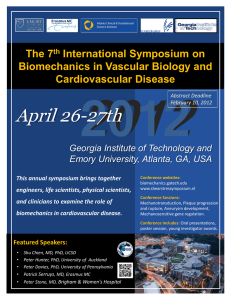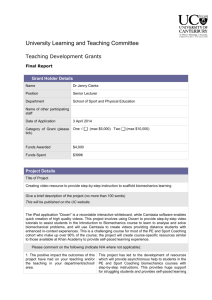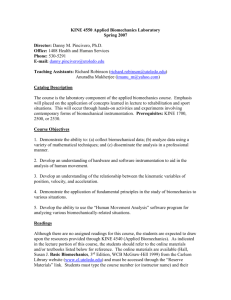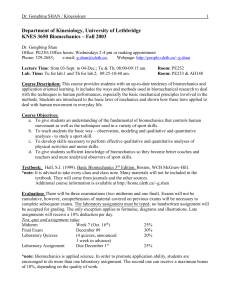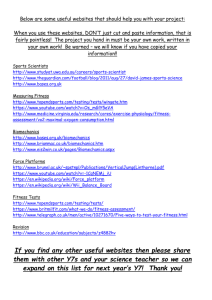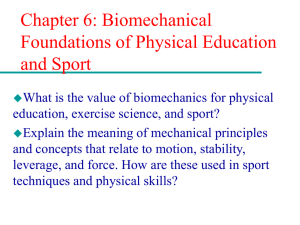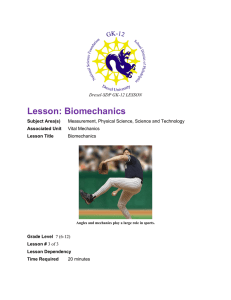University of Kent
advertisement
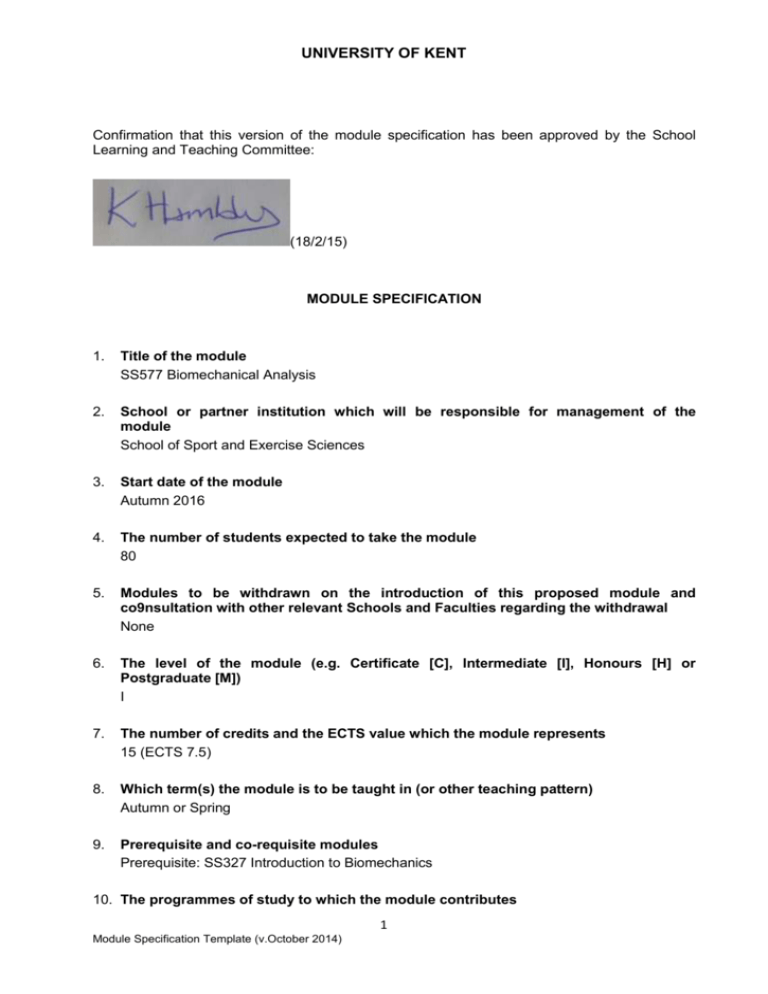
UNIVERSITY OF KENT Confirmation that this version of the module specification has been approved by the School Learning and Teaching Committee: (18/2/15) MODULE SPECIFICATION 1. Title of the module SS577 Biomechanical Analysis 2. School or partner institution which will be responsible for management of the module School of Sport and Exercise Sciences 3. Start date of the module Autumn 2016 4. The number of students expected to take the module 80 5. Modules to be withdrawn on the introduction of this proposed module and co9nsultation with other relevant Schools and Faculties regarding the withdrawal None 6. The level of the module (e.g. Certificate [C], Intermediate [I], Honours [H] or Postgraduate [M]) I 7. The number of credits and the ECTS value which the module represents 15 (ECTS 7.5) 8. Which term(s) the module is to be taught in (or other teaching pattern) Autumn or Spring 9. Prerequisite and co-requisite modules Prerequisite: SS327 Introduction to Biomechanics 10. The programmes of study to which the module contributes 1 Module Specification Template (v.October 2014) UNIVERSITY OF KENT BSc Sport and Exercise Science MSci Applied Sport and Exercise Science 11. The intended subject specific learning outcomes On successful completion of this module, students will be able to: 1. Apply Newton’s Laws to whole body and segmental angular motion. 2. Identify the steps involved in computing resultant joint moments using a two dimensional inverse dynamics procedure and critically discuss methodological issues involved in collecting the necessary data. 3. Explain the advantages of muscle indeterminacy and the limitations of an inverse dynamics analysis. 4. Interpret a joint moment-time profile to identify common gait issues. 5. Recognise a typical stress-strain relationship for biological tissues and the changes in mechanical properties that occur with training, ageing and disuse. 12. The intended generic learning outcomes On successful completion of this module, students will be able to: 1. Apply knowledge to the solution of familiar and unfamiliar problems – evidenced via the selection and solution of appropriate equations to gain insight into human movement principles. 2. Communication, presentation, numeracy and C & IT skills – evidenced via the completion of calculations in seminars and assessments, the use of computer software to aid in the collection and processing of biomechanical data, and the interpretation in worksheets and assessments of this data. 3. Interactive group skills – evidenced via the collection and analysis of biomechanical data in groups. 4. Problem solving skills – evidenced via the completion of calculations and data analysis. 5. Ability to self-appraise and reflect on practice - achieved through the completion of formative online quizzes and the completion of in class exercises. 6. Ability to plan and manage learning – through completing the extra self-directed study and optional online exercises necessary to successfully complete the required assignments and tasks throughout the module. 13. A synopsis of the curriculum This module is concerned with angular mechanics and the biomechanics of complex movements. Laboratory experimentation will provide the opportunity for students to develop practical skills in the use of a range of analysis equipment such as a force plate and computer-based motion analysis. A range of sport and exercise situations will be used to illustrate the mechanical principles considered. These could include kinematic analysis of walking; the kinetics of weight lifting; the computation of resultant joint moments and gait analysis. Indicative content includes: • Definition and computation of angular kinematic quantities. • Newton's Laws in their angular formulation. • Methodology: motion analysis, force plates, anthropometry. • Interpretation of resultant joint moment profiles in gait analysis. • Basic material properties such as stress and strain and the relationship between these measures and injury. 2 Module Specification Template (v.October 2014) UNIVERSITY OF KENT 14. Indicative Reading List Hamill, J. and Knutzen, K.M. (2009) Biomechanical basis of human movement. 3rd Ed. London: Lippincott Williams and Wilkins. Hay, J.G. (1993) The biomechanics of sports techniques. 4th Ed. Englewood Cliffs NJ: Prentice-Hall. McGinnis, P. (2005) Biomechanics of sport and exercise. 2nd Ed. Champaign, IL: Human Kinetics. Nordin, M. and Frankel, V. H. (2001) Basic biomechanics of the musculoskeletal system. 3rd Ed. London : Lippincott Williams & Wilkins. Nigg, B. and Herzog, W. (2007). Biomechanics of the Musculoskeletal System. 3rd Ed. Chichester: Wiley & Son. Winter, D. A. (2009) Biomechanics and Motor Control of Human Movement. 4th Ed. Chichester: Wiley & Son 15. Learning and Teaching Methods, including the nature and number of contact hours and the total study hours which will be expected of students, and how these relate to achievement of the intended module learning outcomes Lecture (All LOs): 11 hours Seminar / practical (All LOs) 11 hours Reading (11.1-11.5; 12.1, 12.6) 33 hours Completion of calculations after seminar or practical (11.1-5; 12.1, 12.2, 12.4-6) 22 hours Review of online support material and self-test quizzes (11.1-5; 12.1, 12.2, 12.4-6) 33 hours Completion of assessments (All LOs) 40 hours TOTAL 150 hours 16. Assessment methods and how these relate to testing achievement of the intended module learning outcomes Assessment Type Weighting Learning Outcomes Assessed Coursework (Extended laboratory 100% report to include independent written data interpretation and methodological criticism from exemplar data) 11.1, 11.2, 11.3, 11.4, 11.5; 12.1, 12.2, 12.3, 12.4, 12.5, 12.6 17. Implications for learning resources, including staff, library, IT and space The module will be convened by an existing member of the School of Sport and Exercise Sciences. Library and IT resources will be mainly provided by using existing provision given that the Drill Hall Library already contains a good selection of books relevant to the module. Teaching will take place in existing lecture theatres, computer rooms and laboratories. The module makes use of an existing site licence for specialist biomechanics software. A small amount of laboratory consumables will be required and simple demonstration apparatus can be fabricated using existing University workshops. 3 Module Specification Template (v.October 2014) UNIVERSITY OF KENT 18. The School recognises and has embedded the expectations of current disability equality legislation, and supports students with a declared disability or special educational need in its teaching. Within this module we will make reasonable adjustments wherever necessary, including additional or substitute materials, teaching modes or assessment methods for students who have declared and discussed their learning support needs. Arrangements for students with declared disabilities will be made on an individual basis, in consultation with the University’s disability/dyslexia support service, and specialist support will be provided where needed. 19. Campus(es) or Centre(s) where module will be delivered: Medway 4 Module Specification Template (v.October 2014)
